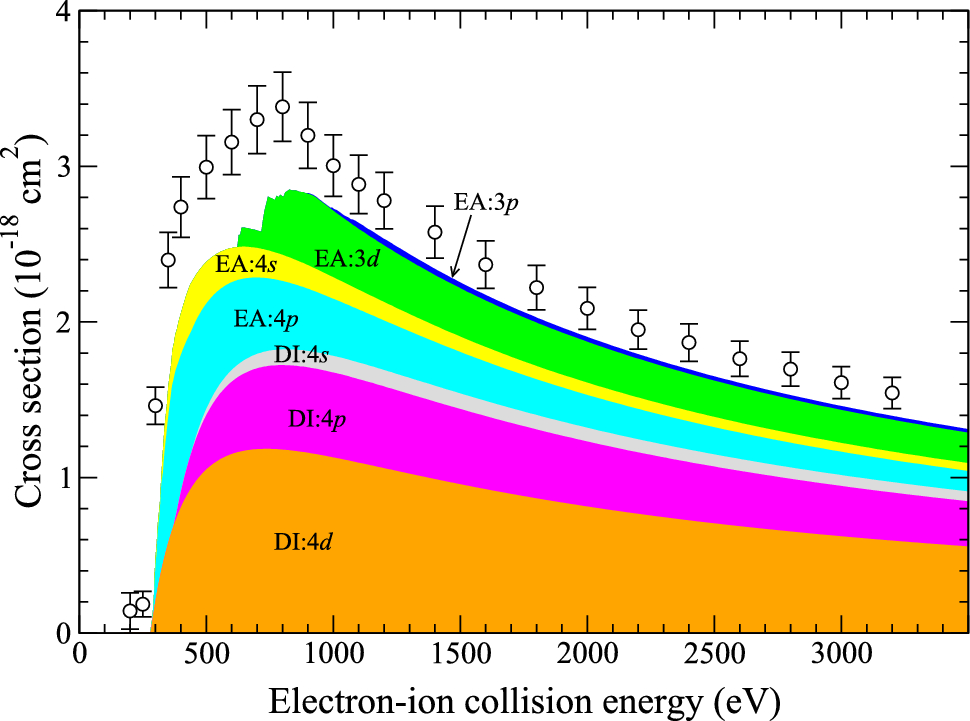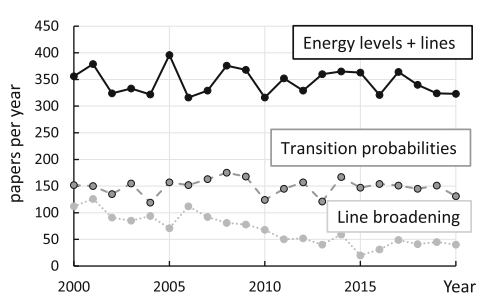EPJ D Highlight - Electron-impact ionization calculations match with experiments
- Details
- Published on 24 June 2024

Through a new calculation approach, researchers have made far more accurate predictions of how atoms are ionized when impacted by high-energy electrons.
During electron-impact ionization (EII), high-energy electrons collide with atoms, knocking away one or more of their outer electrons. To calculate the probability that ionization will occur during these impacts, researchers use a quantity named the ionization ‘cross-section’. EII is among the main processes affecting the balance of charges in hot plasma, but so far, its cross-section has proven incredibly difficult to study through theoretical calculations.
Through new research published in EPJ D, Stefan Schippers and colleagues at Justus-Liebig University of Giessen, Germany, present new calculations for the EII cross-section, which closely match with their experimental results. Their discoveries could provide useful new insights in many fields of research where hot plasma is studied: including astrophysics and controlled nuclear fusion.
EPJ D Topical Issue - Atomic and Molecular Data and Their Applications: ICAMDATA 2022
- Details
- Published on 21 June 2024

Guest Editors: Annarita Laricchiuta, Iouli E. Gordon, Christian Hill, Gianpiero Colonna and Sylwia Ptasinska
Atomic and Molecular Data and Their Applications: the generation, collection and diffusion of accurate and consistent atomic and molecular (AM) data is crucial in various fields of science and technology, requiring the cross-disciplinary cooperation of AM data producers and users and the coordination of AM data activities and databases.
The Topical Issue collects 20 papers, giving a snapshot of the efforts of the community in the field of data production and curation. The majority of the papers are focused on the theoretical derivation of structural properties of atoms and molecules and of dynamical data (cross sections and rate coefficients) for electron scattering and heavy-particle collision processes, with different approaches. Some papers presenting experimental activity are also included in the collection. Published results contribute to the construction of new knowledge and aim at giving answer to data needs in different fields of application, ranging from astrophysics and fusion plasmas to low-temperature plasmas for technological discharges and aerothermodynamics. Another relevant topic is the data collection and dissemination through the existing web infrastructures, establishing criteria and indicators for the critical and systematic analysis and formulating new paradigms and best practices.
This Topical Issue stems from the 12th International Conference on Atomic and Molecular Data and Their Applications (ICAMDATA), held in Mola di Bari (Italy) in September 2022.
All articles are available here and are freely accessible until 18 August 2024. For further information read the Editorial.
EPJ D Highlight - A new simple scheme for atom interferometry
- Details
- Published on 13 May 2024

New scheme proposes a simpler method for investigating matter waves with an ease of use that could make it ideal for commercial applications
Atom interferometers are devices that use the wave characteristics of matter to measure the phase between atomic matter waves to separate paths to make high-precision measurements of elements of physics, such as gravitational and magnetic fields. Atom interferometers have also found their way into industry and are used in geological surveys, mineral exploration, environmental monitoring, and for the development of precision atomic clocks.
Atom interferometers usually control matter waves and particularly particle velocity using lasers. Thus, the growth of atom interferometer application has been strongly tied to the development of advanced laser systems, with many current models based on the construction of gratings fashioned from laser beams. That means that an issue with these systems is the fact that they depend on the efficient operation of intricate laser systems. Additionally, while this method has achieved commendable precision, it fails slightly when considering shorter wavelengths.
EPJ D Highlight - Probing neptunium’s atomic structure with laser spectroscopy
- Details
- Published on 08 May 2024

A new technique developed by researchers in Germany can measure ionisation states of this element more precisely than before, with implications for its detection and remediation in radioactive waste.
The radioactive element neptunium is one of the principal components of nuclear waste. Mass spectrometry can be used to probe its complex atomic structure, which is of value both for its intrinsic interest and for determining the isotope composition of neptunium waste. Magdalena Kaja at Johannes Gutenberg University, Mainz, Germany and her co-workers have now demonstrated a novel method of laser spectroscopy that can analyse the ionisation potential of neptunium more precisely than earlier methods. This work is now published in the journal EPJ D.
EPJ D Highlight – Estimating uncertainty in atomic spectroscopy
- Details
- Published on 17 April 2024

A numerical toolbox offers a robust way to evaluate uncertainty in atomic wavelength measurements.
If you repeat a measurement with the same or different instruments, you’ll get slightly different numbers each time. Estimating the uncertainties associated with these numbers turns them into an informative result. In a study published in EPJ D, Alexander Kramida, of the National Institute of Standards and Technology in Maryland, USA, now explains a new statistical approach for estimating the uncertainty associated with atomic spectroscopy measurements. He discusses how this approach can be applied both to measurements of spectral line wavelengths, and to other atomic properties that are indirectly determined from them.
EPJ D Topical Issue: Dynamics and Photodynamics: From Isolated Molecules to the Condensed Phase
- Details
- Published on 17 January 2024

Guest Editors: Luis Bañares, Ramón Hernández-Lamoneda, Pascal Larregaray, Germán Rojas-Lorenzo and Jesús Rubayo-Soneira
Dynamics and photodynamics: from isolated molecules to the condensed phase is a highly interdisciplinary topical issue with numerous connections between traditional branches of physics and chemistry.
The issue provides a snapshot of current research in different areas of molecular systems science. It consists of 12 contributions representing both experimental and theoretical studies, ranging from fundamental mechanisms to more applied levels, which are essential in numerous applications of nanotechnology and material science. The contributions featured in this issue encompass a wide range of areas, including spectroscopy, photodissociation, dynamics of reactions involving neutral and charged cluster systems, carbon nanotubes and various other subjects.
This topical issue is celebrating the 20th anniversary of the Photodynamics Conference, held in Havana in November 2022.
All articles are available here and are freely accessible until 15 March 2024. For further information read the Editorial.
EPJ D Topical Issue: Physics of Ionized Gases and Spectroscopy of Isolated Complex Systems: Fundamentals and Applications
- Details
- Published on 06 November 2023

Guest Editors: Bratislav Obradović, Jovan Cvetić, Dragana Ilić, Vladimir Srećković and Sylwia Ptasinska
This EPJ D Topical Issue presents selected papers covering a wide range of topics from fundamental studies to applications of ionized gases: Atomic Collision Processes - Electron and Photon Interactions with Atomic Particles, Heavy Particle Collisions, Swarms and Transport Phenomena; Particle and Laser Beam Interactions with Solids - Atomic Collisions in Solids, Sputtering and Deposition, Laser and Plasma Interaction with Surfaces; Low Temperature Plasmas - Plasma Spectroscopy and other Diagnostic Methods, Gas Discharges, Plasma Applications and Devices; General Plasmas - Fusion Plasmas, Astrophysical Plasmas and Collective Phenomena.
EPJ D Highlight - Creating optical logic gates from graphene nanoribbons
- Details
- Published on 09 October 2023

A new graphene-based optical logic gate uses collective oscillations of electrons to process light waves in a far smaller space than existing designs. The device also benefits from low information loss and high stability.
Research into artificial intelligence (AI) network computing has made significant progress in recent years, but has so far been held back by the limitations of logic gates in conventional computer chips. Through new research published in EPJ D, a team led by Aijun Zhu at Guilin University of Electronic Technology, China, introduce a graphene-based optical logic gate, which addresses many of these challenges.
EPJ D Highlight - Machine learning hunts for the right mix of hydrogen isotopes for future nuclear fusion power plants
- Details
- Published on 31 August 2023

New research is an initial step in the use of deep learning to help determine the right mix of hydrogen isotopes to use in fusion power plants of the future
The process that powers the stars, nuclear fusion, is proposed as a future power source for humanity and could provide clean and renewable energy free of the radioactive waste associated with current nuclear fission plants.
Just like the fusion process that sends energy spilling out from the Sun, future nuclear fusion facilities will slam together isotopes of the universe’s lightest element, hydrogen, in an ultra-hot gas or “plasma” contained by a powerful magnetic field to create helium with the difference in mass harvested as energy.
One thing that scientists must know before the true advent of fusion power here on Earth is what mix of hydrogen isotopes to use— primarily “standard” hydrogen, with one proton in its atomic nucleus, deuterium with one proton and one neutron in its nucleus, and tritium with a nucleus of one proton and two neutrons. This is currently done with spectroscopy for prototype fusion devices called tokamaks, but this analysis can be time-consuming.
In a new paper in EPJ D, author Mohammed Koubiti, Associate Professor at the Aix-Marseille Universite, France, assesses the use of machine learning in connection with plasma spectroscopy to determine the ratios of hydrogen isotopes for nuclear fusion plasma performance.
EPJ D Topical Issue: Electron-Driven Processes from Single Collisions to High-Pressure Plasmas
- Details
- Published on 30 August 2023

Guest Editors: Jose L. Lopez, Michael Brunger, and Holger Kersten
The special Topical Issue of the European Physics Journal D (EPJ D) on “Electron-Driven Processes from Single Collisions to High-Pressure Plasmas” is published to honor Kurt H. Becker, who served as Editor-in-Chief for the journal from 2010 to 2016, on his 70th birthday. Electron-driven processes from single collisions to high-pressure plasmas definitely occupy a central position in atomic and plasma physics. Considering this, the Guest Editors compilated a broad range of original manuscripts that encompass the area of electron-atom and electron-molecular collisions, respectively, low-temperature plasma research and aligning with Kurt Becker’s emphasis on science innovation and entrepreneurship. Hence, the papers focus on various recent scientific and technological advances in this given area of physics, chemistry and technology of non-thermal plasmas.




